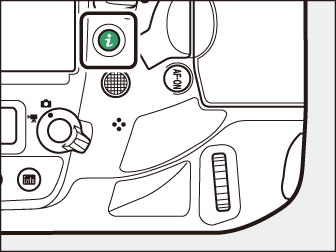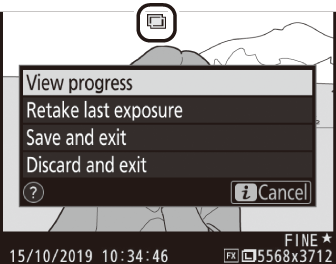Combining Multiple Exposures in a Single Photo (Multiple Exposure)
Use the [] item in the photo shooting menu to record two to ten NEF (RAW) exposures as a single photograph.
Multiple Exposure Options
|
Option |
Description |
|---|---|
|
[] |
|
|
[] |
Choose the number of exposures that will be combined to form a single photograph. |
|
[] |
|
|
[] |
|
|
[] |
|
|
[] |
Choose the first exposure from the NEF (RAW) images on the memory card. |
Creating a Multiple Exposure
-
Highlight [] in the photo shooting menu and press 2.
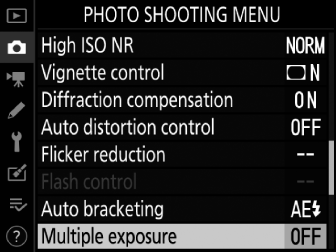
-
Choose an option for [].
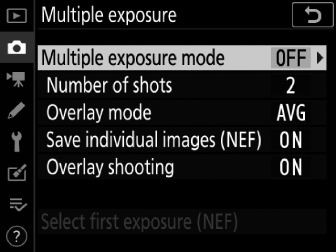
-
Highlight [] and press 2.
-
Highlight a multiple exposure mode using 1 or 3 and press J.
-
A n icon is displayed in the top control panel when [] or [] is selected.
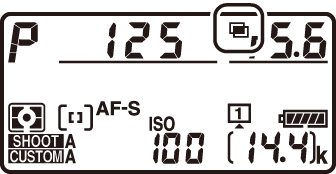
-
-
Choose a value for [] (number of exposures).
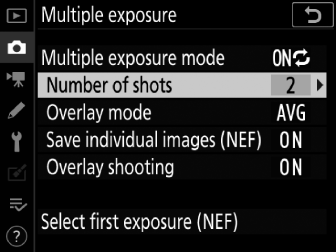
-
Highlight [] and press 2.
-
Choose the number of exposures using 1 or 3 and press J.
-
-
Choose an option for [].
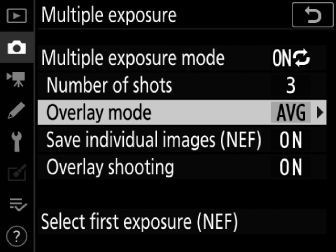
-
Highlight [] and press 2.
-
Highlight an option using 1 or 3 and press J.
-
-
Choose a setting for [].
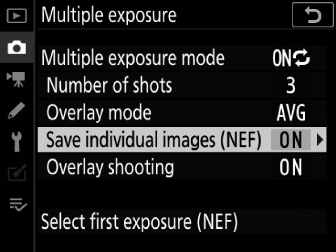
-
Highlight [] and press 2.
-
Highlight an option using 1 or 3 and press J.
-
To save both the multiple exposure and the shots that make it up, select []; the individual shots are saved in NEF (RAW) format. To save only the multiple exposure, select [].
-
-
Choose an option for [].
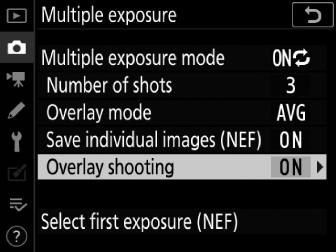
-
Highlight [] and press 2.
-
Highlight an option using 1 or 3 and press J.
-
Select [] to superimpose earlier exposures on the view through the lens in live view.
-
-
Choose an option for [].
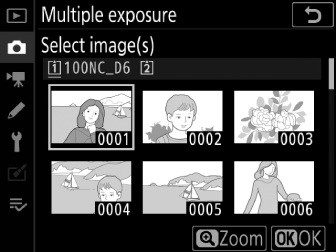
-
To choose the first exposure from existing NEF (RAW) photos, highlight [] and press 2.
-
Use the multi selector to highlight the desired picture.
-
To view the highlighted picture full frame, press and hold the X button.
-
To view pictures in other locations, press W (M) and choose the desired card and folder in the [] dialog.
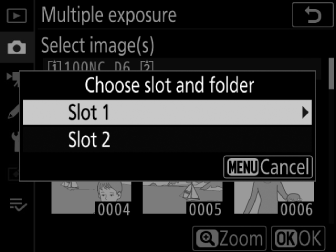
-
After highlighting the desired picture, press J.
-
If an NEF (RAW) image taken at an ISO sensitivity of Hi 0.3 to Hi 5 is selected as the first exposure, the electronic shutter will not be used to record the remaining shots even if [] is selected for Custom Setting d6 [].
-
-
Start shooting.
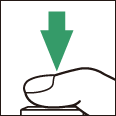
-
The n icon will flash.
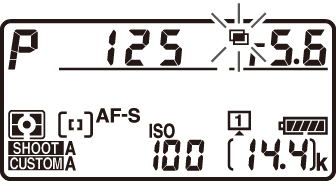
-
Take the selected number of shots. If you used [] to select an existing NEF (RAW) image as the first exposure in Step 7, shooting will start from the second exposure.
-
The number of exposures remaining in the current multiple exposure can be displayed by pressing the shutter-release button halfway between shots.
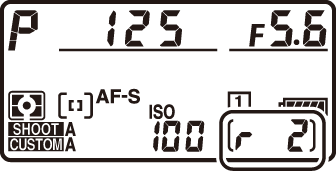
-
Once you have taken the selected number of shots, the pictures will be overlaid to create a multiple exposure. Multiple exposures are recorded in JPEG format regardless of the option selected for image quality.
-
If [] is selected, the camera will exit multiple exposure mode and the n icon will clear from the display once the number of shots selected in Step 3 has been taken and the multiple exposure has been recorded.
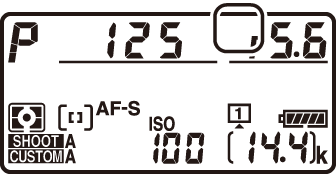
-
If [] is selected for [], you can continue to take additional multiple exposures until [] is selected.
-
-
Voice memos can be recorded once shooting is complete. You cannot record voice memos while shooting is in progress.
-
If you use the monitor for menu navigation or playback while shooting a multiple exposure, remember that shooting will end and the multiple exposure will be recorded if no operations are performed for about 30 seconds after the monitor has turned off. The time available to record the next exposure can be extended by choosing longer times for Custom Setting c2 [].
-
Multiple exposures may be affected by “noise” in the form of randomly-spaced bright pixels, fog, or lines.
-
In
ClandChmodes and during silent burst photography in mode Q, the camera will take pictures while the shutter-release button is pressed and record a multiple exposure once the selected number shots has been taken. If [] is selected for multiple exposure mode, multiple exposure mode will end once a multiple exposure has been recorded. If [] is selected, the camera will continue to record multiple exposures while the shutter-release button is pressed. -
In self-timer mode ( Using the Self-Timer (E) ), the interval between each shot in the exposure is selected using Custom Setting c3 [] > []. Regardless of the value selected for the c3 [] option, shooting will however end after the number of shots selected for the multiple exposure.
-
Shooting settings and photo info for multiple exposure photographs are those for the first exposure.
-
Do not remove or replace the memory card while a multiple exposure is in progress.
-
Memory cards cannot be formatted while a multiple exposure is in progress. Some menu items will be grayed out and unavailable.
When [] is selected for Custom Setting f3 [] > [], [] (Step 2) and [] (Step 3) can be selected using the BKT button and command dials.
-
Hold the BKT button and rotate the main command dial to choose from the following multiple exposure modes: a ([]), 1 ([]), and b ([]).
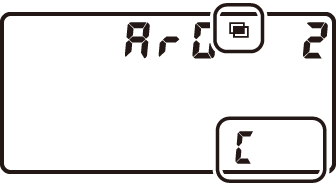
-
You can choose the number of shots by holding the BKT button and rotating the sub-command dial until the desired value is displayed in the top control panel.
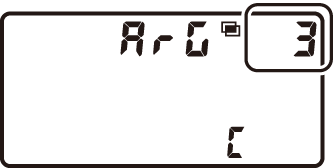
Multiple exposure cannot be combined with some camera features, including:
-
Movie recording
-
Bracketing
-
HDR (high dynamic range)
-
Interval-timer photography
-
Time-lapse movies
-
Focus shift
Using the i Button
Pictures can be viewed by pressing the K button while a multiple exposure is in progress. The most recent shot in the current multiple exposure is indicated by a n icon; pressing the i button when this icon is present displays the multiple exposure i menu.
|
|
|
-
Highlight items and press J to select.
-
You can also have the option of using touch controls after pressing the i button.
|
Option |
Description |
|---|---|
|
[] |
View a preview created from the exposures recorded to the current point. |
|
[] |
Retake the most recent exposure. |
|
[] |
Create a multiple exposure from the exposures taken to current point. |
|
[] |
Exit without recording a multiple exposure.
|
Ending Multiple Exposures
To end a multiple exposure before the specified number of exposures have been taken,
select [] for multiple exposure mode. A multiple exposure will be created from the exposures
that have been recorded to that point (if [] is selected for [], gain will be adjusted to reflect the number of exposures actually recorded).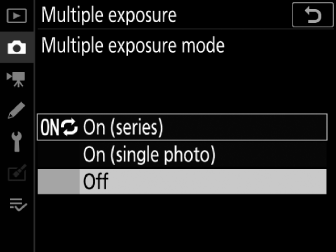
The multiple exposure will also end if:
-
a two-button reset is performed,
-
the camera is turned off,
-
the battery is exhausted, or
-
you press the K button followed by the i button and select either [] or []



